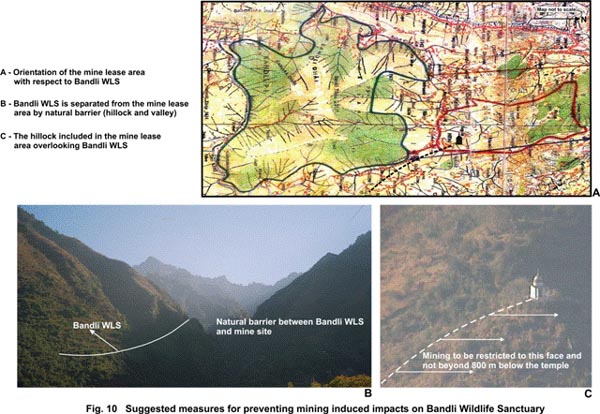Mitigation of impacts on Bandli Wildlife Sanctuary
|
The evaluation of ecological impacts of the mining activities under the proposed project on Bandli WLS essentially focused on potential threats to its integrity as a Protected Area and implications of project-induced secondary impacts on its conservation value. Bandli WLS is separated from the mine lease area by a natural barrier of a hillock and by intervening valley occupied by human habitation in villages such as Maloh. The impacts of mining are therefore not likely to directly threaten the integrity of the PA. Based on the approved mine plan for extraction of limestone from within the mineralised blocks in lease area, mining would be restricted within defined limits of existing Bagain village and within the specified face of the hill slope overlooking Bandli WLS. Considering the significance Bandli WLS commands as a Protected Area for conservation of rare and threatened species in restricted and specialised habitats, preventive approaches for safeguarding its ecological and biodiversity characteristics will essentially require adherence to the limits of mining up to a maximum of 800 m below the temple and within the specified face in the southern part of the mine lease area as illustrated in Fig. 10. Mining beyond the specified limits within the mine lease area will threaten the barrier function of the intervening hillock and valley area. In order to further strengthen the viability of the barrier function of the intervening hill and for promoting movement of animals between Bandli WLS and the forest area outside southern edge of mine lease, habitat improvement work would have to be undertaken. An estimate is already provided by HPFD for creating this functional linkage for ensuring long term connectivity between the forested areas (Annexure – VII ). This amount would have to be transferred to HPFD to initiate habitat improvement work before the mineral extraction process is taken up.
As is evident from the baseline, in the existing scenario, the landscape surrounding Bandli WLS is dotted with as many as fifty-four villages with human population of over 13,800 and nearly 9000 livestock (Annexure – V & VI) already posing a major challenge for conservation. Bandli WLS may consequently become a major receptor of additional impacts due to increased resource dependencies of oustees from the mine lease area and from influx of work force for mining activities especially in the absence of a clearly laid-out policy for resettlement of project oustees. The HPFD has already initiated eco-development planning (Annexure – VII) for reducing impacts of pressures from the surrounding villages on Bandli WLS. The changing ground realities with new dimensions of ecological impacts from development activities including that from the proposed project would need to be incorporated in eco-development planning for the Sanctuary for ensuring efficacy of conservation measures. The Eco-development Plan for the area adjoining Bandli WLS prepared by the HPFD indicates a total budgetary provision of Rs. 94.93 lakhs over a period of four years for undertaking various activities under the identified components of the plan. The key components include – Afforestation, Pasture Development, Wildlife Habitat Improvement, Soil Conservation Works and Eco-development (Annexure – VII). A realistic approach would require allocation of the major proportion of funds in the first phase to be able to undertake adequate safeguards for arresting potential impacts in the initial phase of the proposed project. A closer look of the yearwise budgetary abstract indicates that the amounts allocated for investments on activities under various components differ for each year with a minimum of Rs. 45.73 lakhs allocated in the first year, Rs. 31.00 lakhs allocated in the second year, Rs. 12.90 lakhs allocated in the third year and the remaining Rs. 5.30 lakhs in the fourth year. These allocations are expected to cover the much enlarged scope of activities for eco-development planning in the light of increasing pressures likely to be induced with the shifts in resource dependencies from the area diverted for the proposed project. The implementation of the Eco-development Plan should consider prioritising the villages for receiving the benefits of the habitat improvement and community welfare works to target at preventing the impacts on Bandli WLS in the earliest phase of plan implementation. In the absence of a well-defined R&R plan at the time of this study for safeguarding community welfare and resource needs, a community consultation programme taking into account community priorities and needs should be taken up by the project authorities to significantly improve the R&R plan and thereby the relationship between the project authorities and the local community. The effective implementation of mitigation plan would require a strong partnership between the project authorities, HPFD and the local communities which can only be nurtured by reciprocal arrangements in benefit sharing and harmonizing of objectives of environmental conservation. |
Last Updated: October 6, 2015










